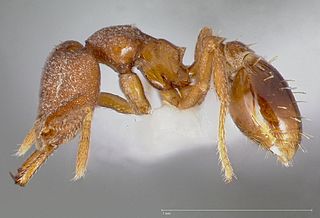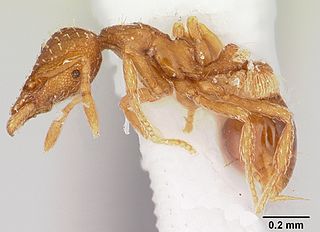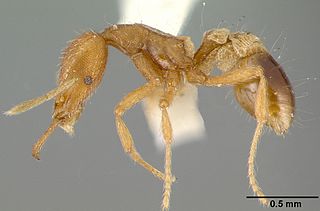Barry Bolton is an English myrmecologist, an expert on the classification, systematics, and taxonomy of ants, who long worked at the Natural History Museum, London. He is known especially for monographs on African and Asian ants, and for encyclopaedic global works, including the Identification Guide to Ant Genera (1994), A New General Catalogue of Ants of the World, Synopsis and Classification of Formicidae (2003), and Bolton's Catalogue of Ants of the World: 1758-2005 (2007). Now retired, Bolton is a Fellow of the Royal Entomological Society and Myrmecologist, Biodiversity Division, Department of Entomology, Natural History Museum, London.

Strumigenys xenos is a species of ant in the subfamily Myrmicinae. It is found in Australia and New Zealand. Its IUCN Red List status was last updated in 01 August 1996, and could be outdated.

Strumigenys is a genus of ants in the subfamily Myrmicinae.

Strumigenys emmae is a species of ant in the genus Strumigenys. It is 1.5 millimeters long and is yellowish brown, has a 4 segmented antennae, small eyes, and has hairs on the head, mesosoma, and petiole that are mostly scale-like or orbicular. They are difficult to find other than when encountered in leaf litter samples or pitfall traps. They are normally slow moving, but they can move fast when disturbed. The species first strike usually kills its prey. The species colony is small. It is most often found in beach margins and agricultural areas.

Strumigenys metazytes is a species of ant that has a distinct diastema on the basal portion of the mandibles with 4 sharp teeth and the species has small hairs. The species was described by Bolton in 2000.
Strumigenys trada is a species of ant that was discovered and described by Lin, C. C. & Wu, W. J. in 1996.
Strumigenys formosensis is a species of ant endemic to Taiwan. It is widely distributed within the island at low and middle elevations.

Strumigenys godeffroyi is a species of ant. This is a very widespread species found in South East Asia as far east as southern India and Sri Lanka, and also Indonesia, the Philippines, Taiwan, New Guinea, northern Australia and much of Oceania.
Strumigenys liukueiensis is a species of ant endemic to Taiwan.
Strumigenys nanzanensis is a species of yellow ant endemic to Taiwan.
Strumigenys inopinata is a species in the genus Strumigenys. It is found in Sri Lanka.

Strumigenys lewisi, is one of more than 185 species in the genus Strumigenys. It is found in Philippines, Sri Lanka, Myanmar, Taiwan, Vietnam, China, North Korea, Japan, Malta, and South Korea. The ant is sometimes known as Japanese ant, due to its type specimen was found from Japan.
Strumigenys veddha, is one of more than 185 species in the genus Strumigenys found in Sri Lanka.
Colaspis louisianae is a species of leaf beetle from North America. It is distributed in Texas and Louisiana in the United States. It is close in appearance to Colaspis brunnea.

Hypoponera punctatissima, or Roger's ant, is a species of ant in the family Formicidae.

Strumigenys ayersthey is a species of ant found in Chocó region of Ecuador. It is the only species belonging to the group of Strumigenys that has a long jaw, bigger jaw structure and lacks stretches in its cuticule.









